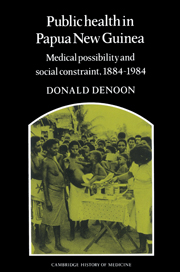Book contents
- Frontmatter
- Contents
- Acknowledgements
- Maps of Papua New Guinea
- Introduction
- I The rise and fall of tropical medicine
- 1 Pre-colonial health and disease
- 2 The administration of public health
- 3 Early colonial medical administration
- 4 The political economy of health in Papua between the wars
- 5 The political economy of health in New Guinea between the wars
- 6 Medical education
- 7 The Pacific War: the condition of the people
- II The rise and fall of the great campaigns
- Notes
- Bibliography
- Index
7 - The Pacific War: the condition of the people
Published online by Cambridge University Press: 11 February 2010
- Frontmatter
- Contents
- Acknowledgements
- Maps of Papua New Guinea
- Introduction
- I The rise and fall of tropical medicine
- 1 Pre-colonial health and disease
- 2 The administration of public health
- 3 Early colonial medical administration
- 4 The political economy of health in Papua between the wars
- 5 The political economy of health in New Guinea between the wars
- 6 Medical education
- 7 The Pacific War: the condition of the people
- II The rise and fall of the great campaigns
- Notes
- Bibliography
- Index
Summary
The military imagery which coloured medical discussions in New Guinea between the wars reflected Australia's traumatic tradition as supplier of shock-troops for the British Empire. Yet the Pacific War caught the Australian government unprepared. Military planners certainly expected a world war – but a re-run of the Great War. The troops were equipped to fight on the Western Front, but were actually sent to North Africa and to the Middle East, which had been a sideshow in the Great War. The soldiers were equipped badly for the North African desert, and not at all for New Guinea. Some had been despatched to Malaya, lest the Japanese join in the war. When Singapore fell, and Japanese forces swept through the western Pacific to occupy the Bismarck Archipelago in January 1942, most Australian troops were either committed in the Middle East or captured in South East Asia. Only the tiny garrisons in Rabaul and Port Moresby had direct experience of jungle conditions. Between 1942 and 1945, the brutal fighting in the Solomons and New Guinea would be won by those armies best able to maintain their fighting strength in enervating temperatures and humidity, beset by endemic malaria and epidemic dysentery.
Japan entered the Pacific War with every advantage of experience. As early as 1904, during their war against Russia, they had demonstrated that military discipline could restrict non-battle casualties. Since the early 1930s, their armies had been deployed abroad in Manchuria and China: their medical officers had experienced every environmental and logistical problem.
- Type
- Chapter
- Information
- Public Health in Papua New GuineaMedical Possibility and Social Constraint, 1884–1984, pp. 58 - 64Publisher: Cambridge University PressPrint publication year: 1989



